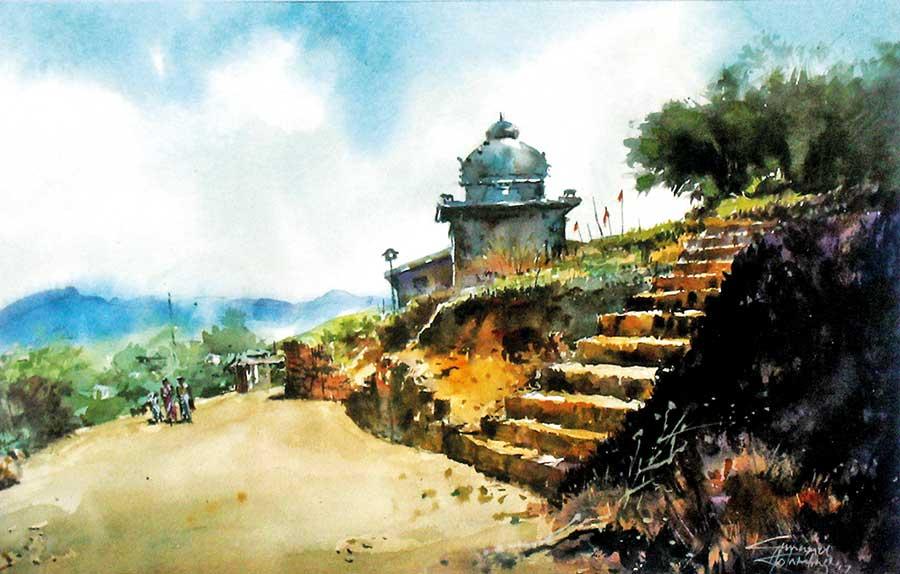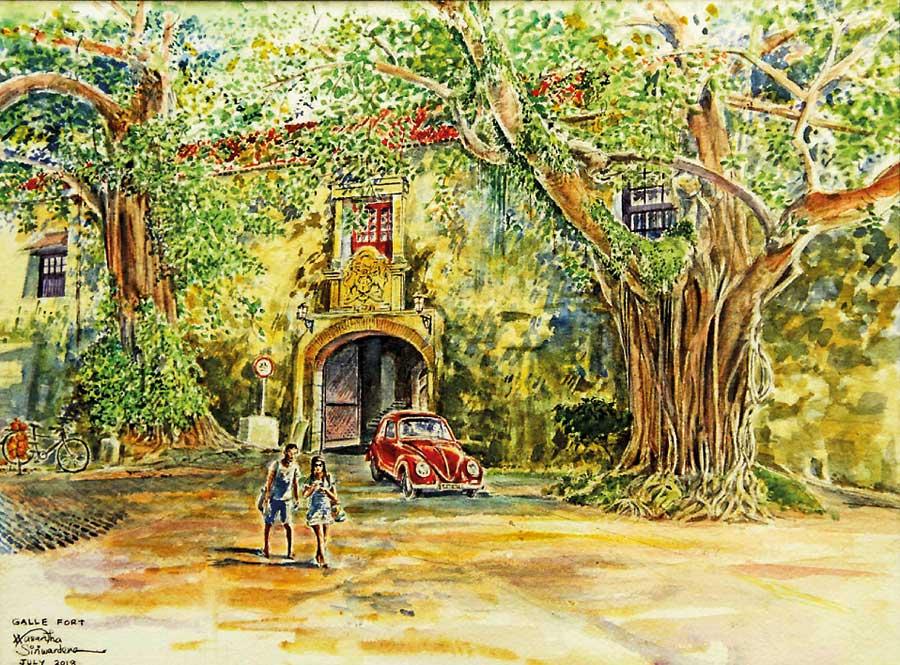Reply To:
Name - Reply Comment

Wasantha Siriwardena-Beruwela
Launching the group’s work, from the first exhibition named ‘Odyssey,’ will be held at the Colombo Art Gallery in Stratford Avenue Colombo 06 and Plate Loft Gallery Colombo 03, in April 2021. The exhibition will be open for four weeks
|
Shanaka Kulatunga
|
In today’s world of uncertainty and change, digitization, symbolism and psychedelia, the Purest of Art forms are losing appreciation and acceptance. This is unfortunately true of the art scene in Sri Lanka as well. Therefore, a group of senior artists of different disciplines, practising distinctive styles of their own, have banded together under the name 2020 Group, in order to shift the spotlight back to Representational Art.
What is Representational Art?
The term Representational Art straddles several sub-styles all of which require a solid foundation of study and practice before an artist finds his or her unique method of expression.
As its name suggests, Representational Art represents something that already exists. The subjects range from objects of nature and scenery to houses, furniture and portraits as well as moments and aspects of life.
Here, the extent of Realism captured with brush strokes and detailed or simplified forms is entirely up to the artist as long as the subject is recognizable as something that exists.
Therefore, the opposite of Representational Art is considered to be Abstract Art also known as Non-Representational Art.
Abstracts may be created based on objects or emotions on the part of the artist but appear to the viewer as a collection of shapes, forms and colours. Furthermore, it is harder to critique Abstract Art since it is not based on a recognized genre or style. World-famous Abstract artists such as Matisse and Picasso, who were friends, contemporaries and competitors, explored many classical styles and colour palettes before they ventured into the abstract.
However, today in Sri Lanka as opposed to the rest of the world, most young artists choose to take up Abstract Art purely because they feel it is higher in commercial value and requires less painstaking study, skill and crafting.
Commenting on this trend, Kalabhooshana Brindley Jayatunga, Past President of the Ceylon Society of Arts and internationally practising senior artist, a co-founder of the 2020 Group said what caused the trend was a commercially driven market.
“Unfortunately, this is largely due to the lack of appreciation from critiques, commercially-driven markets and the inclinations or preferences of art teachers who influence students and young artists to follow their own styles.”
“In other words, Representational Art extends to different levels of Realism in several varying styles,” explained Kala Bhooshana Gunasiri Kolambage a veteran artist and founder member of the 2020 Group.
 "Today in Sri Lanka as opposed to the rest of the world, most young artists choose to take up Abstract Art purely because they feel it is higher in commercial value and requires less painstaking study, skill and crafting"
"Today in Sri Lanka as opposed to the rest of the world, most young artists choose to take up Abstract Art purely because they feel it is higher in commercial value and requires less painstaking study, skill and crafting"
“All of us in the Group can be classified as supporters of Representational Art, although our work varies vastly.”
Impressionism is an important area of this classification, infusing feelings and emotions into its creation as evinced by the works of such artists like Van Gogh and Monet, where the use of brush strokes are key.
Also under the broad umbrella of Representational Art is Idealism under which da Vinci’s Renaissance Art is classified. His in-depth study of the human body, muscles and muscle tones are evident in his work. Another aspect of this art form is Stylization as evinced by the artist David Hockney whose early work included expressionist elements and later took on the style of pop art. Figurative Art which is the portrayal of figures and nudes is also categorized under Representational Art.
 "The concern for the preservation and development of Representational Art in Sri Lanka brought this eclectic group of artists together. They are committed to work towards the upliftment and education of Representational Art by taking on a planned and structured approach"
"The concern for the preservation and development of Representational Art in Sri Lanka brought this eclectic group of artists together. They are committed to work towards the upliftment and education of Representational Art by taking on a planned and structured approach"
|
Charitha Lay-APARNA
|
2020 Group
The concern for the preservation and development of Representational Art in Sri Lanka brought this eclectic group of artists together. They are committed to work towards the upliftment and education of Representational Art by taking on a planned and structured approach.
Launching the group’s work, from the first exhibition named ‘Odyssey,’ will be held at the Colombo Art Gallery in Stratford Avenue Colombo 06 and Plate Loft Gallery Colombo 03, in April 2021. The exhibition will be open for 4 weeks.
They hope to re-ignite interest and passion for this art form and to seek international recognition for Sri Lankan artists who are immersed in it.
“Currently we have 12 senior artists as members, bringing in a wide and varied set of experiences and fields of expertise to the table,” said Sunil Katugampola, the co-founder and curator of the Group.
“There was the 43 Group in Sri Lanka, consisting of famous artists like Richard Gabriel, Justin Daraniyagala and George Keyt who believed in deviating from the classical trends and establishing distinctively Sri Lankan Modernist art. Today we feel the need to rekindle the pursuit of Representative Art and are ready to do what it takes to achieve our goals.”
|
Senani Senanayke
|
Objectives of 2020 Group
By keeping abreast of international best practices in the field of Representational Art, the members of the 2020 Group are striving to raise the bar of art in Sri Lanka and pave the way for international acceptance and recognition.
They also hope to participate in local and international art forums to establish Sri Lanka as a strong contender in the field of Representational Art. Towards this goal, they will be organizing and facilitating the participation of local artists at art exhibitions, workshops, international art fairs, competitions and art auctions.
Also on the cards is participating in artists’ exchange programmes, adding paintings to international art museums and collections, getting published in international art magazines, selling paintings online internationally and providing for signature membership of key art societies.
“Education is an important aspect of the plans for the 2020 Group,” explained artist, Dillai Joseph.
“We have drawn up a calendared activity plan so that we approach this in an organized and structured way. Through this, we also hope to attract sponsors and supporters of the arts in order to make these goals a reality.”
Commenting further on the work planned for the future, Brindley Jayatunga said, “there is a need for a proper art gallery that showcases all styles of work, representational work and nonrepresentational work of Sri Lankan artists.”
 "As its name suggests, Representational Art represents something that already exists. The subjects range from objects of nature and scenery to houses, furniture and portraits as well as moments and aspects of life"
"As its name suggests, Representational Art represents something that already exists. The subjects range from objects of nature and scenery to houses, furniture and portraits as well as moments and aspects of life"
|
Dillai Joseph - Kumbuk
|
He went on to say that this could be a place for discussion on various topics of art with conducted tours, somewhat
like at the museum, where students can see and study different art forms. Public lectures by local and international artists would be held and made accessible to everyone with an interest in art.
This could be the launching pad for a movement and lobby to create awareness about up-and-coming artists and attract different stakeholders in the country who patronize and support art in Sri Lanka. Furthermore, there could be organized places for all artists, not only those who are registered with the Group, to gather for discussions, networking and painting.
“We want to inspire local artists as well as aspiring artists to engage in Representational work and be secure in the knowledge that they will receive encouragement and appreciation for their efforts,” said Dr Shanaka Kulathunga.
Towards this end, the Group hopes to conduct workshops and courses on specific areas of art in different mediums for artists to acquire a solid foundation of the different styles and genres of art.
“Another area we want to focus on is restoration and conservation,” said Sunil Katugampola.
“It is a specialized technique possessed by highly trained professionals outside the Group specializing in this field, and we want to support such work in order to preserve the acclaimed work of our master artists”.
The 2020 Group will pave the way for revisiting the art forms of the Greats in history, whilst encouraging young artists to explore a wide selection of genres based not on the marketability of commercial value, but rather on their particular passions and skills.

List of artists in the group
(Bottom Left to right) Dillai Joseph, Nihal Sangabo Dias, Charitha Lay, Brindley Jayatunga, Sunil Katugampola, Gunasiri Kolambage, Senani Senanayake, Basil Cooray
(Top Left to Right ) Anupa Perera, Shanaka Kulathunga, Wasantha Siriwardena, Sachith Graham De Silva

Gunasairi Kolmbage-KOVIL IN TEA ESTATE-HATTON

Wasantha Siriwardena